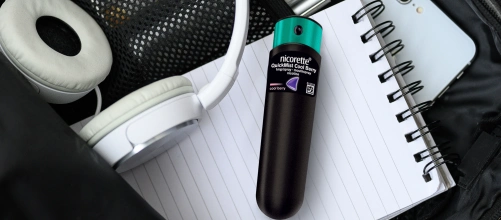There are different approaches to stopping smoking. One of them is quitting smoking cold turkey. This means you stop using all tobacco products immediately and without using Nicotine Replacement Therapy (NRT) or stop-smoking medication of any kind.
While quitting cold turkey does work for some and may be the best approach for certain people, it’s not always the most effective method. Only 3 to 5 in 100 smokers stop smoking for good by going cold turkey, and many need extra support to stop successfully.
If you're taking medication for other conditions, make sure you inform your pharmacist or doctor that you plan to quit smoking so they can talk you through the best options for you.
Quitting cold turkey challenges
Some people choose to quit smoking through willpower alone. If you can do it, quitting smoking cold turkey is a great way to stop. It means using no nicotine replacement therapy (NRT) or other support methods to alleviate the cravings you’re likely to experience along the way. However, it can be a more challenging and less effective option than getting support throughout your quit journey.
Whatever method you choose to quit smoking, you're likely to experience two types of cravings:
Background cravings - Steady and constant cravings, these can typically be alleviated with long-lasting NRT products like nicotine patches.
Sudden cravings - Intense cravings that come on suddenly that can be treated with fast-acting NRT products such as gums or mouth sprays.
When giving up smoking cold turkey, these cravings go untreated, which often result in relapse. In fact, up to 76% of unaided quitters end up relapsing within the first week.
Get tips on how to stay on track and manage your cravings.
Quitting smoking cold turkey vs Nicotine Replacement Therapy

NRT is suitable for most people and can help improve your chances of quitting successfully compared to giving up smoking cold turkey. This is because NRT treatments can help keep your cravings under control and reduce unpleasant withdrawal symptoms.
Using two forms of NRT together can help people quit more effectively than using just one. Known as combination therapy, which uses a patch for background craving control alongside a fast-acting form like gum, nasal spray, or an inhalator to target those sudden, triggered cravings.
Picking the right NRT product will depend on your personal preferences and cravings.
You can try:
Nicorette Gum – Acts fast to help you deal with cravings.
Nicorette Invisi Patch – Helps protect you against 7 withdrawal symptoms*.
Nicorette Cools Lozenge – For smokers who want flexible but discreet control of cravings, even after the lozenge is gone.
Nicorette Quickmist Mouthspray – Starts to relieve cravings in 30 seconds and is proven to more than double your chances of stopping smoking successfully compared to quitting with willpower alone.
*Cravings, irritability, low mood, restlessness, anxiety, poor concentration and increased appetite
How to quit smoking cold turkey if it’s the right option
While NRT can improve your chances of successfully quitting smoking, going cold turkey can be preferable for some. If you want to quit through willpower alone, here are some top tips to help you quit successfully.
GET SUPPORT
Getting some support can be a huge help when you’re trying to quit smoking.
Professional support can be provided by stop smoking services which can help make you three times more likely to quit than with will power alone. Having friends and family around you means you'll have people to encourage and support you. It can also help to have someone to confide in about your challenges. Your friends and family can also help by asking how you're getting on and reminding you of your commitment to quit.
Make a quit smoking plan
It's important to prepare before quitting smoking cold turkey to help you deal with any cravings or triggers. Identifying situations that may make you tempted to smoke and planning how to avoid these can help prevent relapses by ensuring you're ready to deal with cravings and temptation.
You can use our My Quit Plan to track your progress and support your quitting journey.
Cut down before your quit date
Setting a date to quit for good within six weeks or earlier from when you decide to stop will help you plan your quitting journey. Cutting down before that date can help you take each day at a time and can often make stopping smoking more manageable. Of course, this does mean you're still smoking for longer, and even a small amount of cigarette smoke will damage your health. But it's a step in the right direction and can help many people on their way to quitting for good.
Be prepared for withdrawal symptoms
Cravings and withdrawal symptoms will affect most people trying to quit smoking, and these can be more challenging without NRT. You should prepare for certain symptoms, including:
Irritability and anxiety
Problems sleeping
Potential weight gain
Cravings
Making a plan for handling these is important. You can try:
Exercising to reduce your symptoms.
Distracting yourself with another activity when your cravings hit.
Frequently asked questions
Is it better to quit smoking gradually or cold turkey?
Even smoking a small amount can damage your health. So, there are more health benefits to quitting cold turkey compared to cutting down before quitting.
However, reducing your smoking before giving up completely can be an easier approach for many people, taking you in the right direction one day at a time. Quitting cold turkey has a high risk of relapse, so if you're nervous about relapsing, cutting down might be right for you – as long as you make a plan and set a clear quit date.
What happens if you suddenly stop smoking?
When you suddenly stop smoking, you're likely to face withdrawal symptoms. These can include intense cravings, which can start as quickly as half an hour after your last cigarette. You may also experience other withdrawal symptoms including:
Mood swings
Irritability
Anxiety
Insomnia or a disturbed sleeping pattern
Less energy
Weight gain
Remember, these withdrawal symptoms are only temporary and should only last around four weeks. If you’re concerned about these withdrawal symptoms, you should speak to your doctor.
How long does cold turkey nicotine withdrawal last?
Cravings are especially tough during the first week of quitting, as cravings are at their most intense two to three days after your last cigarette, but they should only last up to five minutes. They'll typically stop altogether within six weeks. Your other withdrawal symptoms should start to ease in around two to four weeks.
Should you quit smoking cold turkey when pregnant?
You should try to completely quit smoking cold turkey if pregnant. Quitting smoking cold turkey will immediately benefit both you and your baby during pregnancy. For starters, you will no longer be exposed to the harmful chemicals such as carbon monoxide that comes from smoking. This will significantly reduce the risk of complications during pregnancy and the chances of a stillbirth, while minimising any potential smoking-related complications in your baby’s life, such as low birth weight and cot death.
If you are unable to stop smoking by going cold turkey, you can consider using nicotine replacement therapy (NRT) during pregnancy to help you on your stop smoking journey. Before using NRT products, speak to your GP or pharmacist.
Is quitting cold turkey dangerous?
From the moment you quit smoking, your body begins the recovery process. Quitting cold turkey isn’t dangerous but it’s a good idea to consider getting proper support throughout your quit journey. Your chances of quitting are 3x higher vs unaided if you use behavioural support. You can also use NRT to help boost your chances of quitting for good.
How can you make quitting cold turkey easier?
It’s hard to change a long-term habit on your own, so getting support from friends, family, and professionals can help you successfully quit smoking. There are plenty of organisations that provide expert support.
Quitting will also involve identifying your triggers and learning how to manage cravings. You can also try to get rid of things that remind you of smoking and start seeing yourself as non-smoker to help boost your determination to quit for good. Additionally, staying active can help curb cravings and alleviate withdrawal symptoms. Remember your reasons for quitting and be sure to find time to give yourself a break, as avoiding stressful situations can help during the initial weeks of quitting.




